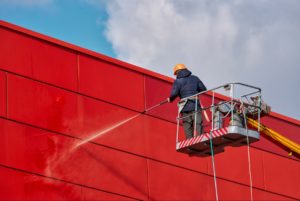
In this article, we will discuss the issue that can be the reason for the pressure washer, not building pressure.
Causes Of Pressure Not Building
If the pressure washer is working but fails to produce the proper pressure, then there can be several reasons behind it. The leading cause of the problem is that the pressure washer is not getting enough water that it should get. This results in lower pressure than usual.
Some other common issues which cause the pressure washer low-pressure are:
Not Enough Water
If there is not enough water going in the pressure washer, it will create a low pressure problem. A simple experiment can quickly diagnose it. Remove the garden hose from the inlet and check the GPM of the water coming from the hose. If this is lower than the recommended pressure flow rate, which is usually 2 to 3 GPM, then this is the cause of low pressure. This can be due to less water in the tank or clogging of the garden hose.
Pulsating
If the garden hose is cleared, then the problem is in the pressure washer. Check for the pulsation in the working of the pressure washer. If the pressure washer is vibrating in the working and struggling to provide pressure, it is probably due to the pump malfunction or dirt built up in the pump. Open the pump and check for visible damage, if there is any. Check the valve and connections of the pump for any dirt and debris and remove them. Check the seals of the pump, and if these are damaged, then it is the reason for low pressure.
Unsteady Low Pressure
Unsteady flow pressure is the instant change of water pressure from high to low, and it can also change from low to high. It is mainly due to the fault or malfunction in the water intake system or if there is any air trapped inside the pump. To find out the reason:
- Check that the water tank supplies enough water and there is no air suction in the pump.
- Check for any air leakage in the pump or the hose.
- Check for the suction line for any leaks or cracks, and if there are any, then it is the cause of the low pressure.
Nozzle Clog
With time, the nozzle of the pressure washer can also have some wear and tears that can also cause the low pressure in the pressure washer. Try to change the nozzle and check if the problem is solved.
Loose Belt
Sometimes the belt driving the pump can go loose and slip while providing the power to the pump. This can result in the low rotation speed of the pump, which will ultimately result in the low pressure of the pressure washer. Check for the belt if it is getting hot or is loose. It is better to change the belt after some time to avoid significant damage.
Trigger Malfunction
It is a rare case, but the trigger malfunction can also cause the low pressure of the pressure washer. You may squeeze the trigger, but it does not fully open the water flow passage. As a result, downward pressure would be observed. Check for any malfunction by checking any abnormal behavior of the trigger.
Check More: Why Does My Pressure Washer Have No Pressure
Conclusion
There can be various reasons for the pressure washer not building up enough pressure, and by following the above-discussed procedure, you can reach the root of the problem and solve it. The main reason behind the pressure, not building pressure, is the low flow rate that can be determined easily. Clogging is also another reason for low pressure, and it should be removed immediately to avoid pressure building up inside the pump and causing further damage. The air in the pump can also cause a low-pressure problem that can be used to either air intake with water leakages or air trapped in the pump that is not removed.
- 10 Best Budget Pressure Washer 2023 – Reviews & Buyer’s Guide - December 7, 2022
- 10 Best Pressure Washer for Cars Wash Reviews [2023] - December 6, 2022
- 10 Best Commercial Pressure Washer 2023 –Buyer’s Guide - December 5, 2022
